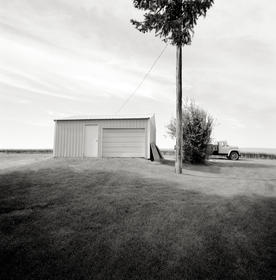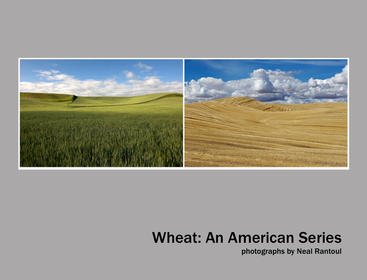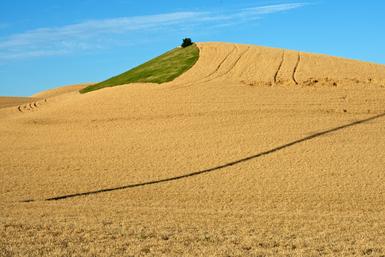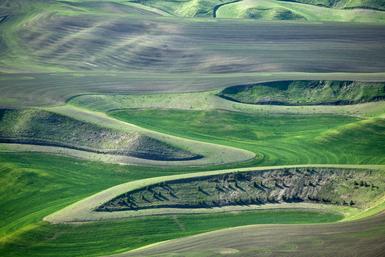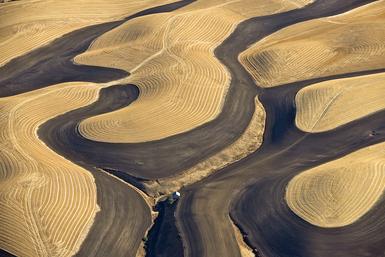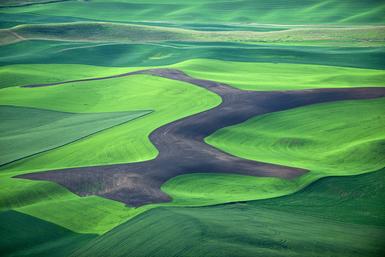A few weeks ago while I was out photographing in the wheat field country called The Palouse in Washington I wrote a post that challenged readers to find a gravestone in a cemetery in Oakesale, WA with the gravemarker "Waldo"
Here's the post: Here's the Deal
I wrote then that anyone that finds the headstone gets a print from the Oakesdale series from me as the prize.
Well, drumroll please, we have a winner!
It is Susan Nalband from 555 Gallery.
I know what you're thinking, "Isn't this the gallery Neal shows his work with?"
Yes, it is but I swear this is not a fixed contest. Out of the blue Susan sent me an email this morning:

and here's my picture of the headstone:

How about that?
Of course, she didn't actually go out there and walk around the cemetery to prove she found it. But she did something better, she found the story behind the marker.
WALDO ALVIN NOLTING died when he was 28 years old and he was single. I wonder what that story is? Farm accident, disease, ill health from serving in WW I?
Thank you, Susan. Please get in touch soon to claim your print, any of your choice from the Oakesdale Series.

Congratulations!
And thank you Mr. Nolting. It is sad you died so young. If there is anything at all after we die, you should know that you lie in a most beautiful spot, on the side of a hill, surrounded by wheat fields and with a tree over you for shade from the summer's heat.
I have to come up for air sometime, right? I can't be only about working on the new Wheat pictures, made over two weeks in late June and early July. Can I?
I have been so inside this work and so consumed by it that everything else feels like it takes second seat to it.
I also have been working on its various subsets which are: wheat on the ground, wheat in the air, the other stuff I shot while out there and two days in Grand Coulee in the center of the the state.
Today I am going to lead off with the aerial work which is now called American Wheat: Function and Form and is the aerial work I made while out there.
There is now an artist statement to the Wheat work in general that also references these new aerials:
Artist Statement: Wheat
Neal Rantoul
I first started
photographing in the Palouse area of southeastern Washington in the mid 90’s
and have been back most years since. It is my longest running project.
The work has
evolved over the years, going from first black and white to color, from large
format to digital, and from being based on the ground to including pictures
made from the air. I have also photographed the area through the seasons.
In earlier writing
about the project I referenced some of the great contemporary landscape
photographers such as Robert Adams and Joe Deal, who was a good friend, and
also cited Eugene Atget for the single mindedness of his intent. As a
career artist I work in many different genres but this is the one that is
perhaps the core vehicle of expression for my landscape work. While it has been
challenging to find new approaches to this most wonderful of places, it also
has been a privilege. Looking back at so much work now, I see more subtle
changes from the earlier days to the present for I believe some of the basic principles in working there still apply: it is a landscape almost without scale
due to few trees and little to reference size, the pictures can convey the
movement of the wheat in the breeze at the same time as show the stillness and
static nature of the topography, allowing photographs that convey
sharpness and blur due to movement in the same image simultaneously and
finally, in the more recent work since about 2000, colors, on their own, but
also in relationship to each other.
I am very excited
by the newest aerial work from the summer of 2014, as it represents a shift in
intention with an evolved sense of the fields' function and their form where
the work is perhaps its most abstract. Some of this work references the place
by including a barn, a farm machine or trees, while some does not. Hence: Function
and Form, the title for the new work. Function and Form constitutes
a subset, which is, I hope, a powerful one, of the overall work made over the
two-week shoot.
Neal Rantoul
July 2014
Function


and Form


Next up?I will be posting most of American Wheat: Function and Form on the site over the next few days.
What's that called? When you've established a precedent earlier in your career then seen what you did years ago gain recognition beyond your own work?
If you're a reader of this blog you know I am back in the wheat growing region of Washington state called The Palouse. I first photographed here in 1993 and have been back most years since. (If you like you can go back into past posts on the wheat work here by clicking Wheat in the blog heading and you can see the actual pictures by clicking on the Gallery section of the site for Northwest.
In the 90's when I was out here I never saw other photographers making pictures along the side of the road. I don't know if I am partly responsible for the growth of popularity of the area for photography but now it is probably the largest tourist attraction for the Palouse. In fact, where I am staying at the Best Western Inn in Colfax, is ground central for the numerous trips, workshops and photo tours that take place here.
Let me give you an example. This morning, I got up early as usual and headed out to shoot. After a few hours on dirt farm roads making these:



I found myself near Pullman where I knew there was a Starbucks. I pulled in, ordered my coffee and turned around looking for a table to sit at. This is what confronted me:

A very large print of the same wheat fields, from the same area I made mine at about the same time of year, overprinted in size a little from a digital file so it wasn't that sharp, but not bad. I wouldn't have included the grain silos on the lower right and would have moved in more to abstract the image, but, not bad.
Pack my bags and head home? No, I will keep photographing. Why? Tough not to get cynical here but because I am doing it as well as or better than everybody, because I have different goals in mind, because my experience here is my strength, because I am working well, seeing possibilities inherent in these fields, because I am making a contribution in this trip to the work I've done here before.
Coming off the other day's post Oakesdale Again, where I explained that I returned to visit the cemetery where I first made a series of pictures in 1996 that were important to me, I have an offer you simply cannot refuse.
Back then, as I wandered through this small cemetery on the side of a hill surrounded by wheat fields I came across this:

which is an upside down small headstone that says: Waldo 1898-1926. This image is the sixth in the series. To me, this is my way of explaining that I found Waldo (from the children's series of books called "Where's Waldo"), and that he is six feet under.
Well, each year when I go back I walk the cemetery and look for that same headstone. I have never found it.
Here's my offer and I think you'll agree it is too good to pass up. I will give to the person that finds that headstone, photographs it as proof and sends me the image, a signed black and white print of the original image made in 1996 of the "Waldo" headstone.
No time limit, no other conditions. Simply find Waldo, please. I can't take it, not being able to locate that headstone.
Oh yes, where is the cemetery? Oakesdale is about equidistant between Spokane and Pullman, Washington, not far from Steptoe Butte. Get to town and ask anyone for the cemetery, there is only one.
First one to nail it gets the prize. Please believe that I am in earnest here. This is a real offer.
Ready set.... go!
My friends, this one may take a little work on your part. I have written at length about the Oakesdale Cemetery series made in 1996. I have written that I believe it is seminal to my oeuvre and, if you are interested in understanding my work at all, a real look at this series is crucial. The work you need to do? Read the posts:http://nealrantoul.com/posts/oakesdale-cemetery
which is the first
then:
http://nealrantoul.com/posts/oakesdale-cemetery-take-2
then:
http://nealrantoul.com/posts/oakesdale-cemetery-take-3
and finally:
http://nealrantoul.com/posts/oakesdale-cemetery-take-4
Why now? Why ask you to take a longer look at a series made almost 20 years ago?
Because I just did. I went back yesterday. Most years when I am here in Eastern Washington I go back to the cemetery in Oakesdale, to see what has stayed the same and what has changed. I also check on what I think of as "Rob's tree"... this one:

which, 18 years later, looks like this:
(Please, no criticism of the second photograph, as inelegant as the black and white is, well, elegant.)
Still struggling and with now a story to go with it. As I was walking around the cemetery yesterday the grounds keeper pulls up and proceeds to show me the new rose garden he and his wife put in and also says how hard it's been to keep up as he had surgery a few of weeks ago. I sympathize and then tell him how I've been tracking this one tree for 18 years and he tells me that the plot is owned by some couple from Oregon and how the plan was to take the tree down a few years ago as it seldom bloomed and had little growth. But the year they were going to end it the tree flourished and the two owners said well, it stays, right? And so it does.So moving to walk around this most essential of places layered over with a meaning so personal and so powerful for me that it is perhaps best just to show your some of what I saw yesterday as words fail me.

One of trees in the row that went from one, to two, to three in the series, almost lost because of over watering, now working its way back to health.
The shed, seen here from a different angle, but really what started the whole series in the first place:
and the original, from 1996:
And finally, a truck, in almost the same location, but a different truck and next to a second shed, built behind the original:

49 years old when I made those, now 67. Whew!Thanks for reading. As always you may reach me with comments, criticism, etc at:
Neal's email



